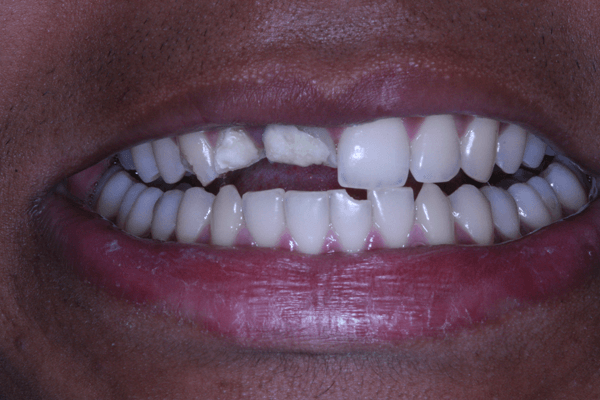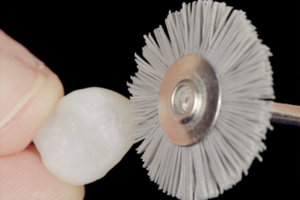Relato de caso descreve o bom comportamento clínico de abordagem restauradora com uso de cimento resinoso reforçado por carga para cimentação do retentor.
AUTORES
Douglas Silva de Almeida
Graduando em Odontologia – Universidade Federal de Pelotas.
Orcid: 0000-0002-2297-7715.
Carolina Schuster Ouriques
Graduanda em Odontologia – Universidade Federal de Pelotas.
Orcid: 0000-0001-6644-4278.
Mateus Bertolini Fernandes dos Santos
Doutor em Clínica Odontológica, área de Prótese Dental – Universidade Estadual de Campinas; Professor adjunto – Faculdade de Odontologia da Universidade Federal de Pelotas.
Orcid: 0000-0001-5477-4077.
Noéli Boscato
Doutora em Clínica Odontológica, área de Prótese Dental – FOP-Unicamp; Professora associada – Faculdade de Odontologia da Universidade Federal de Pelotas.
Orcid: 0000-0002-3817-1732.
César Dalmolin Bergoli
Doutor em Prótese Dentária – Unesp; Professor adjunto – Faculdade de Odontologia da Universidade Federal de Pelotas.
Orcid: 0000-0003-4835-8477.
RESUMO
A reabilitação restauradora de fraturas coronárias em dentes anteriores demanda o restabelecimento tanto da funcionalidade quanto da estética do elemento traumatizado. Esse processo fica ainda mais complexo à medida que necessitamos usar um retentor intrarradicular para a retenção da restauração, pois a técnica de cimentação e reconstrução do núcleo apresenta sensibilidade técnica. No presente relato, o paciente apresentou fraturas de esmalte e dentina dos elementos 13 e 31, que foram restaurados com resina composta, e fraturas de maior extensão no 11 e 12. Para esses, foi realizada a cimentação de pinos de fibra de vidro (PFV), construção do núcleo de preenchimento e cimentação de coroa bilayer em dissilicato de lítio, destacando que para todas essas etapas foi utilizado um cimento resinoso reforçado por carga. Após quatro anos, o paciente retornou para uma consulta de acompanhamento e verificou-se que tanto as restaurações cerâmicas como as de resina composta haviam sobrevivido e não apresentavam nenhuma alteração estética ou de forma (escore 1 para todos critérios de Hickel). Assim, entendemos que a utilização de um cimento resinoso reforçado por fibra mostra-se uma ótima opção a curto prazo para as etapas de cimentação de pinos, construção de núcleos de preenchimento e cimentação de coroas metal free. Além disso, os pinos de fibra e coroas cerâmicas confirmaram seu bom comportamento, conforme já apresentado em outros estudos clínicos.
Palavras-chave – Prótese dentária; Cimentos dentários; Estética dentária; Reabilitação bucal.
ABSTRACT
Restorative rehabilitation of coronary fractures in anterior teeth demands the reestablishment of functionality and aesthetics of the damaged tooth. This process becomes more complex as we need to use an intraradicular retainer for the retention of the restoration, since the cementation technique and core reconstruction steps are prone to errors. In the present report, a patient presents fractures of enamel and dentin on upper right canine and lower left central incisor, which were restored using composite resin, and fractures of several extension on upper right central and lateral incisors. For these, it was planned to use glass fiber posts (GFPs), construction of the core and cementation of the bilayer crown in lithium disilicate with the use of a single reinforced resin cement Allcem Core. The ceramic and composite resin restorations had a score 1 for all Hickel criteria, showing survival and success in 4 years follow-up. Therefore, we understand that reinforced resin cement proves to be an excellent material in the short term for the steps of cementation of posts, core build-up and cementation of metal-free crowns. In addition, GFPs and ceramic crowns confirmed their good clinical performance, as shown by other clinical studies.
Key words – Dental prosthesis; Dental cements; Esthetics dental; Mouth reabilitation.
Recebido em ago/2021
Aprovado em out/2021
Referências
- Pini NIP, Nagata JY, Sundfeld-Neto D, Correr-Sobrinho L, Soares AJ, Aguiar FHB et al. Reestablishing biology, function, and esthetics for fractured, immature incisors. Oper Dent 2015;40(4):341-9.
- Demarco FF, Collares K, Coelho-de-Souza FH, Correa MB, Cenci MS, Moraes RR et al. Anterior composite restorations: a systematic review on long-term survival and reasons for failure. Dent Mater J 2015;31(10):1214-24.
- Sagsen B, Zortuk M, Ertas H, Er O, Demirbuga S, Arslan H. In vitro fracture resistance of endodontically treated roots filled with a bonded filling material or different types of posts. J Endod 2013;39(11):1435-7.
- Sarkis-Onofre R, de Castilho Jacinto R, Boscato N, Cenci MS, Pereira-Cenci T. Cast metal vs. glass fibre posts: a randomized controlled trial with up to 3 years of follow up. J Dent 2014;42(5):582-7.
- Cagidiaco MC, García-Godoy F, Vichi A, Grandini S, Goracci C, Ferrari M. Placement of fiber prefabricated or custom made posts affects the 3-year survival of endodontically treated premolars. Am J Dent 2008;21(3):179-84.
- Ferrari M, Vichi A, Fadda GM, Cagidiaco MC, Tay FR, Breschi L et al. A randomized controlled trial of endodontically treated and restored premolars. J Dent Res 2012;91(7 suppl.):72-8.
- Bergoli CD, Brondani LP, Wandscher VF, Pereira GKR, Cenci MS, Pereira-Cenci T et al. A multicenter randomized double-blind controlled clinical trial of fiber post cementation strategies. Oper Dent 2018;43(2):128-35.
- Cotes C, Cardoso M, Melo RMD, Valandro, LF, Bottino MA. Effect of composite surface treatment and aging on the bond strength between a core build-up composite and a luting agent. J Appl Oral Sci 2015;23(1):71-8.
- Sterzenbach G, Karajouli G, Tunjan R, Spintig T, Bitter K, Naumann M. Damage of lithium-disilicate all-ceramic restorations by an experimental self-adhesive resin cement used as core build-ups. Clin Oral Investig 2015;19(2):281-8.
- Walcher JG, Leitune VCB, Collares FM, de Souza Balbinot G, Samuel SMW. Physical and mechanical properties of dual functional cements – an in vitro study. Clin Oral Investig 2019;23(4):1715-21.
- Tay FR, Pashley DH. Monoblocks in root canals: a hypothetical or a tangible goal. J Endod 2007;33(4):391-8.
- Cortellini D, Canale A. Bonding lithium disilicate ceramic to feather-edge tooth preparations: a minimally invasive treatment concept. J Adhes Dent 2012;14(1):7-10.
- Harada K, Raigrodski AJ, Chung KH, Flinn BD, Dogan S, Mancl LA. A comparative evaluation of the translucency of zirconias and lithium disilicate for monolithic restorations. J Prosthet Dent 2016;116(2):257-63.
- Sailer I, Makarov NA, Thoma DS, Zwahlen M, Pjetursson BE. All-ceramic or metal-ceramic tooth-supported fixed dental prostheses (FDPs)? A systematic review of the survival and complication rates. Part I: single crowns (SCs). Dent Mater 2015;31(6):603-23.
- Namoratto LR, Ferreira RDS, Lacerda RAV, Sampaio Filho HR, Ritto FP. Cimentação em cerâmicas: evolução dos procedimentos convencionais e adesivos. Rev Bras Odontol 2013;70(2):142-7.
- Brondani LP, Pereira-Cenci T, Wandsher VF, Pereira GK, Valandro LF, Bergoli CD. Longevity of metal-ceramic crowns cemented with self-adhesive resin cement: a prospective clinical study. Braz Oral Res 2017;31(8):327-45.
- 17. Saleh M, Taşar-Faruk S. Comparing the marginal leakage and retention of implant-supported restorations cemented by four different dental cements. Clin Implant Dent Relat Res 2019;21(6):1181-8.
- Ghazy M, El-Mowafy O, Roperto R. Microleakage of porcelain and composite machined crowns cemented with self-adhesive or conventional resin cement. J Prosthodont 2010;19(7):523-30.
- Roy AK, Mohan D, Sunith M, Mandokar RB, Suprasidh S, Rajan S. Comparison of shear bond strengths of conventional resin cement and self-adhesive resin cement bonded to lithium disilicate: an in vitro study. J Contemp Dent Pract 2017;18(10):881-6.
- Behr M, Rosentritt M, Regnet T, Lang R, Handel G. Marginal adaptation in dentin of a self-adhesive universal resin cement compared with well-tried systems. Dent Mater 2004;20(2):191-7.
- Camposilvan E, Leone R, Gremillard L, Sorrentino R, Zarone F, Ferrari M et al. Aging resistance, mechanical properties and translucency of different yttria-stabilized zirconia ceramics for monolithic dental crown applications. Dent Mater 2018;34(6):879-90.
- Yin R, Kim YK, Jang YS, Lee JJ, Lee MH, Bae TS. Comparative evaluation of the mechanical properties of CAD/CAM dental blocks. Odontology 2019;107(3):360-7.
- Kaizer MR, Bano S, Borba M, Garg V, dos Santos MBF, Zhang Y. Wear behavior of graded glass/zirconia crowns and their antagonists. J Dent Res 2019;98(4):437-42.
- Rauch A, Reich S, Dalchau L, Schierz O. Clinical survival of chair-side generated monolithic lithium disilicate crowns: 10-year results. Clin Oral Investig 2018;22(4):1763-9.
- Özcan M, Vallittu PK. Effect of surface conditioning methods on the bond strength of luting cement to ceramics. Dent Mater 2003;19(8):725-31.
- Skupien JA, Sarkis-Onofre R, Cenci MS, Moraes RRD, Pereira-Cenci T. A systematic review of factors associated with the retention of glass fiber posts. Braz Oral Res 2015;29(1):1-8.
- Behr M, Rosentritt M, Wimmer J, Lang R, Kolbeck C, Bürgers R et al. Self-adhesive resin cement versus zinc phosphate luting material: a prospective clinical trial begun 2003. Dent Mater 2009;25(5):601-4.





